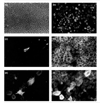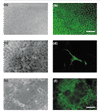A novel cell culture model for studying differentiation and apoptosis in the mouse mammary gland
- PMID: 11056687
- PMCID: PMC13917
- DOI: 10.1186/bcr57
A novel cell culture model for studying differentiation and apoptosis in the mouse mammary gland
Abstract
Background: This paper describes the derivation and characterization of a novel, conditionally immortal mammary epithelial cell line named KIM-2. These cells were derived from mid-pregnant mammary glands of a mouse harbouring one to two copies of a transgene comprised of the ovine beta-lactoglobulin milk protein gene promoter, driving expression of a temperature-sensitive variant of simian virus-40 (SV40) large T antigen (T-Ag).
Results: KIM-2 cells have a characteristic luminal epithelial cell morphology and a stable, nontransformed phenotype at the semipermissive temperature of 37 degrees C. In contrast, at the permissive temperature of 33 degrees C the cells have an elongated spindle-like morphology and become transformed after prolonged culture. Differentiation of KIM-2 cells at 37 degrees C, in response to lactogenic hormones, results in the formation of polarized dome-like structures with tight junctions. This is accompanied by expression of the milk protein genes that encode beta-casein and whey acidic protein (WAP), and activation of the prolactin signalling molecule, signal transducer and activator of transcription (STAT)5. Fully differentiated KIM-2 cultures at 37 degrees C become dependent on lactogenic hormones for survival and undergo extensive apoptosis upon hormone withdrawal, as indicated by nuclear morphology and flow cytometric analysis. KIM-2 cells can be genetically modified by stable transfection and clonal lines isolated that retain the characteristics of untransfected cells.
Conclusion: KIM-2 cells are a valuable addition, therefore, to currently available lines of mammary epithelial cells. Their capacity for extensive differentiation in the absence of exogenously added basement membrane, and ability to undergo apoptosis in response to physiological signals will provide an invaluable model system for the study of signal transduction pathways and transcriptional regulatory mechanisms that control differentiation and involution in the mammary gland.
Figures












Similar articles
-
Overexpression and forced activation of stat5 in mammary gland of transgenic mice promotes cellular proliferation, enhances differentiation, and delays postlactational apoptosis.Mol Cancer Res. 2002 Nov;1(1):32-47. Mol Cancer Res. 2002. PMID: 12496367
-
In vivo and in vitro expression of human serum albumin genomic sequences in mammary epithelial cells with beta-lactoglobulin and whey acidic protein promoters.Mol Reprod Dev. 1999 Mar;52(3):241-52. doi: 10.1002/(SICI)1098-2795(199903)52:3<241::AID-MRD1>3.0.CO;2-X. Mol Reprod Dev. 1999. PMID: 10206655
-
Expression of a carboxy terminally truncated Stat5 with no transactivation domain in the mammary glands of transgenic mice inhibits cell proliferation during pregnancy, delays onset of milk secretion, and induces apoptosis upon involution.Mol Reprod Dev. 2006 Jul;73(7):841-9. doi: 10.1002/mrd.20479. Mol Reprod Dev. 2006. PMID: 16596634
-
The role of Stat3 in apoptosis and mammary gland involution. Conditional deletion of Stat3.Adv Exp Med Biol. 2000;480:129-38. doi: 10.1007/0-306-46832-8_16. Adv Exp Med Biol. 2000. PMID: 10959419 Review.
-
Regulation of milk protein gene expression.Annu Rev Nutr. 1999;19:407-36. doi: 10.1146/annurev.nutr.19.1.407. Annu Rev Nutr. 1999. PMID: 10448531 Review.
Cited by
-
A dual role for oncostatin M signaling in the differentiation and death of mammary epithelial cells in vivo.Mol Endocrinol. 2008 Dec;22(12):2677-88. doi: 10.1210/me.2008-0097. Epub 2008 Oct 16. Mol Endocrinol. 2008. PMID: 18927239 Free PMC article.
-
PML depletion disrupts normal mammary gland development and skews the composition of the mammary luminal cell progenitor pool.Proc Natl Acad Sci U S A. 2009 Mar 24;106(12):4725-30. doi: 10.1073/pnas.0807640106. Epub 2009 Mar 4. Proc Natl Acad Sci U S A. 2009. PMID: 19261859 Free PMC article.
-
A novel approach for the generation of genetically modified mammary epithelial cell cultures yields new insights into TGFβ signaling in the mammary gland.Breast Cancer Res. 2010;12(5):R83. doi: 10.1186/bcr2728. Epub 2010 Oct 13. Breast Cancer Res. 2010. PMID: 20942910 Free PMC article.
-
Proteomic dissection of dome formation in a mammary cell line.J Mammary Gland Biol Neoplasia. 2002 Oct;7(4):373-84. doi: 10.1023/a:1024081914634. J Mammary Gland Biol Neoplasia. 2002. PMID: 12882522 Review.
-
Cellular microenvironment influences the ability of mammary epithelia to undergo cell cycle.PLoS One. 2011 Mar 29;6(3):e18144. doi: 10.1371/journal.pone.0018144. PLoS One. 2011. PMID: 21479230 Free PMC article.
References
-
- Topper YJ, Freeman CS. Multiple hormone interactions in the developmental biology of the mammary gland. Physiol Rev. 1980;60:1049–1056. - PubMed
Publication types
MeSH terms
Substances
LinkOut - more resources
Full Text Sources
Miscellaneous

